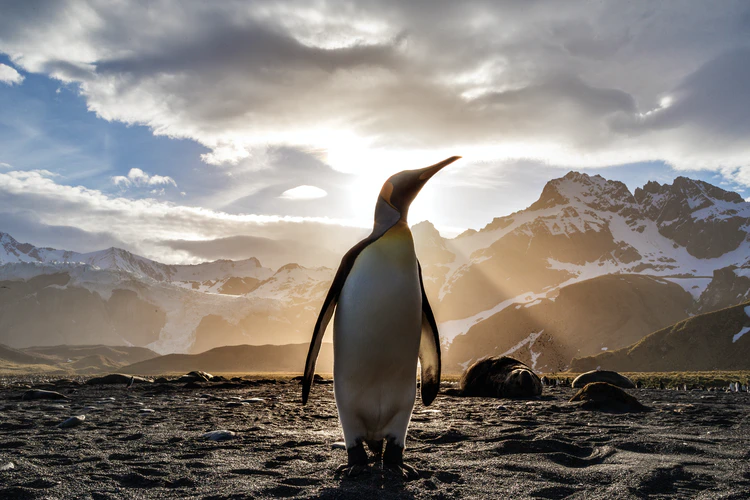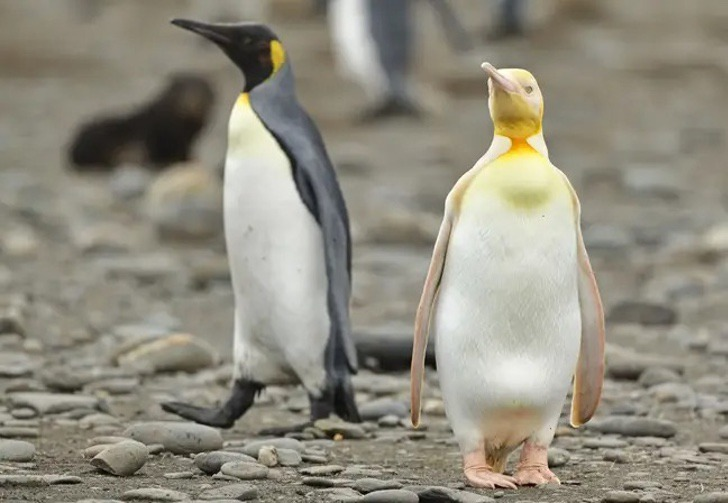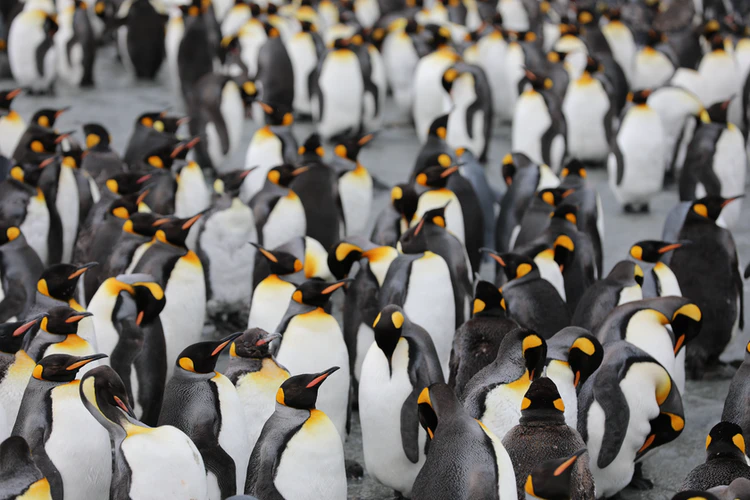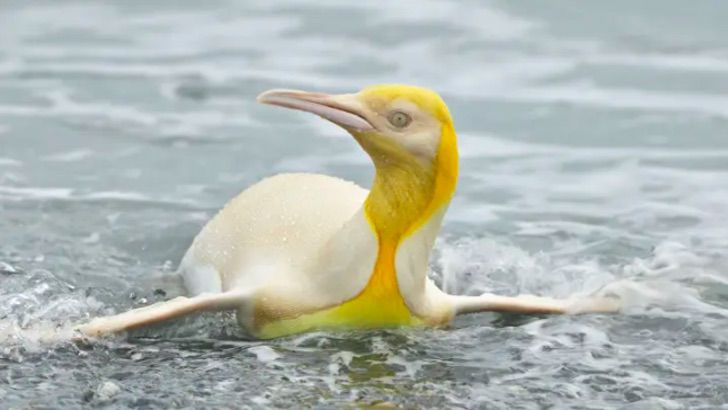Hi There!

Here are our Monthly Biodiversity News for you ^^

Beautiful pictures of a penguin... yellow penguin?!🐧
As you read in the title, Species Hunt dresses up and brings you information about an event captured for the first time in history, photographs of a yellow colored penguin, photographed by the Belgian Yves Adams📸.

Photo credits: Ian Parker
🚩Location: South Georgia and the South Sandwich Islands
A journalistic note published in UPSOCL by Antonio Rosselot
It is a specimen observed in the South Georgia Islands, and although at first glance it seems extremely curious, this color is due to a genetic condition that makes its feathers yellow. The photographer found him in the middle of a colony of around 120,000 king penguins.

Photo credits: Yves Adams😱
🚩Location: South Georgia Islands

Some characteristics of king penguins
The king penguin (Aptenodytes patagonicus) is the second largest penguin in the world only after the emperor penguin (Aptenodytes forsteri). On the upper part of the chest we see a yellowish orange color, the back is gray, its belly is white, the head is black and it has a long, pointed and partially orange bill. The legs are adapted for swimming.
The young of this species are quite curious, since they have brown feathers that have the appearance of hair. They feed on Krill, small fish and other species (BirdLife International, 2012).

Photo credits: Paul Carroll
🚩Location: South Georgia Islands

The Yves Adams experience
"There are few of us who have had the pleasure and privilege of seeing penguins in their natural habitat, but in any case, surely all of us here are capable of identifying a specimen that is different from the others. The figure of penguins is universally white and black, and it is extremely rare to see another color combination "commented the Belgian.
The photographer never thought that he would come across something never seen before. Fortunately, he had a camera to capture the specimen. He witnessed this specimen when he was in the middle of his expedition to the southernmost corners of the planet, specifically the islands of South Georgia, where one of the largest king penguin colonies in the world is located.

Photo credits: Martin Wettstein
🚩Location: South Georgia Islands
The photographer and the rest of the tourists went down in the bay of this island to portray the birds, which in this sector number more than 120 thousand specimens. While Yves was preparing his photographic equipment, he saw a sea of black and white fur circling the beach, but one of them caught his attention, that was the yellow penguin.
"I had never seen or heard of a yellow penguin before. There were 120 thousand birds on that beach and this was the only one of that color. They all looked normal except this one, it was an incredibly unique experience." Yves Adams

The reason?
Yves Adams himself commented that this specimen had leucism, so its body did not produce melanin like other penguins, and this gave it this curious coloration.

Photo credits: Yves Adams😱
🚩Location: South Georgia Islands
Without a doubt, a phenomenon that we would all enjoy if we were there!😱

Did you find the information interesting❓🐧
Do you think this sighting can be repeated soon❓😦
Let us know what you think in the comments❗️

DNA - Densifying Nature-Appreciation

DNA is a not-for-profit organization with the aim to foster and DENSIFY NATURE-APPRECIATION and to establish REPORTS OF BIODIVERSITY DATA that is contributed by all of us Hiveans and subsequently cataloged and published on a public accessible website one day by the DNA Team.
Therefore DNA searches for HIGH-QUALITY posts that aim to DETERMINE and DESCRIBE and the BIODIVERSITY AROUND YOU with added EXPLANATIONS and INFORMATION. If you want to participate you will find a TEMPLATE IN the DNA DISCORD that you can use for this purpose. You can then PUBLISH your posts in any of our assigned DNA COMMUNITIES that are mentioned below and leave your link the the SPECIES HUNT CHANNEL that is also located in the DNA DISCORD. We will do the compilation and one day the publication on our website for you ^^
DNA also offer a CURATION SERVICE, using the @dna.org account, for all your SPECIES HUNT or other BIODIVERSITY RELATED posts that we find in one of the 3 assigned communities. It is also a CURATION TRAIL. Just add the #dna TAG if you think that any of your posts is what they may be looking for. But our MAIN FOCUS will always be on the SPECIES HUNT posts.
At the moment DNA is also the home of the #amazingnature for all your post about the amazing nature all around us, the #featheredfriends for all you great posts about our feathered friends and the #fungilovers for all your posts about fungi and mushrooms ^^ But we hope that more nature related communities will join, or maybe some Hiveans start their own little project there ;) .. Maybe even you?
If you are INTERESTED in DNA, please do not hesitate to ask about it, or directly JOIN US in the DNA DISCORD ;)
"By The People, For The People"
Best wishes,
Biol. Juan Bacab G.🐬

An interesting find, pretty neat and a once in a lifetime moment! If that find can be repeated is a good question. If the penguin survives long enough maybe.
Penguins are countershaded and while this topic is barely touched as readable in my source there are some specifics about it.
Usually thought to prevent from being detected by prey when swimming, or from above, there is the chance that this might be a disadvantage for this specific penguin.
But there is also another disadvantage that might occur, freezing.
So I hope that this special penguin survives and is maybe reproducing, but that's another question if this also leads to a disadvantage regarding this topic.
But definitely a great shot and if it can be repeated scientist might take a closer look at it.
By the way in my previous post about the Dinosaur Cold Case I talk about the finding of the best preserved dinosaur worldwide, where they have figured out that he was also countershaded. Little teaser ;)
Great article and I hope many join with their comments :).
Congratulations @dna.org! You have completed the following achievement on the Hive blockchain and have been rewarded with new badge(s) :
Your next target is to reach 700 comments.
You can view your badges on your board and compare yourself to others in the Ranking
If you no longer want to receive notifications, reply to this comment with the word
STOPCheck out the last post from @hivebuzz:
Partial loss of pigmentation makes so much difference in the wild, always standing out in the crowd.
Locally in Africa we have the White Lions with same condition where I first learned about how this is different to Albinism.
Fortunately not in the public eye and able to continue life in remote region.
Interesting seeing this bird the photographer must have been ever so excited!
@tipu curate
Upvoted 👌 (Mana: 84/112) Liquid rewards.
A blond penguin how cool! What a great blog thank you for the share